Simulation of an Asian Dust Storm Event in May 2017
Abstract
1. Introduction
2. Data and Methods
2.1. Data
2.2. Numerical Simulation
3. Results and Discussion
3.1. Synoptic Conditions during the Dust Storm Event
3.2. Analysis of Meteorological Conditions and Model Validation
3.3. Importance of Using A Local Dust-Size Distribution
4. Conclusions
Author Contributions
Funding
Acknowledgments
Conflicts of Interest
References
- Chow, J.C.; Watson, J.G.; Houck, J.E.; Pritchett, L.C.; Rogers, C.F.; Frazier, C.A.; Egami, R.T.; Ball, B.M. A Laboratory Resuspension Chamber to Measure Fugitive Dust Size Distributions and Chemical-Compositions. Atmos. Environ. 1994, 28, 3463–3481. [Google Scholar] [CrossRef]
- Huang, X.; Song, Y.; Zhao, C.; Cai, X.; Zhang, H.; Zhu, T. Direct radiative effect by multicomponent aerosol over China. J. Clim. 2015, 28, 3472–3495. [Google Scholar] [CrossRef]
- Duce, R.A.; Unni, C.K.; Ray, B.J.; Prospero, J.M.; Merrill, J.T. Long-range atmospheric transport of soil dust from Asia to the tropical North Pacific: Temporal variability. Science 1980, 209, 1522–1524. [Google Scholar] [CrossRef] [PubMed]
- Prospero, J.M. Long-term measurements of the transport of African mineral dust to the southeastern United States: Implications for regional air quality. J. Geophys. Res. Atmos. 1999, 104, 15917–15927. [Google Scholar] [CrossRef]
- Tegen, I.; Lacis, A.A.; Fung, I. The influence on climate forcing of mineral aerosols from disturbed soils. Nature 1996, 380, 419–422. [Google Scholar] [CrossRef]
- Li, L.; Sokolik, I.N. The Dust Direct Radiative Impact and Its Sensitivity to the Land Surface State and Key Minerals in the WRF-Chem-DuMo Model: A Case Study of Dust Storms in Central Asia. J. Geophys. Res. Atmos. 2018, 123, 4564–4582. [Google Scholar] [CrossRef]
- Huang, X.; Wang, Z.; Ding, A. Impact of Aerosol-PBL Interaction on Haze Pollution: Multi-Year Observational Evidences in North China. Geophys. Res. Lett. 2018, 45, 8596–8603. [Google Scholar] [CrossRef]
- Tang, M.J.; Huang, X.; Lu, K.D.; Ge, M.F.; Li, Y.J.; Cheng, P.; Zhu, T.; Ding, A.J.; Zhang, Y.H.; Gligorovski, S.; et al. Heterogeneous reactions of mineral dust aerosol: Implications for tropospheric oxidation capacity. Atmos. Chem. Phys. 2017, 17, 11727–11777. [Google Scholar] [CrossRef]
- Maring, H.B.; Duce, R.A. The Impact of Atmospheric Aerosols on Trace-Metal Chemistry in Open Ocean Surface Seawater. 3. Lead. J. Geophys. Res. Ocean. 1990, 95, 5341–5347. [Google Scholar] [CrossRef]
- Washington, R.; Todd, M.C. Atmospheric controls on mineral dust emission from the Bodele Depression, Chad: The role of the low level jet. Geophys. Res. Lett. 2005, 32. [Google Scholar] [CrossRef]
- Zhang, X.Y.; Arimoto, R.; An, Z.S. Dust emission from Chinese desert sources linked to variations in atmospheric circulation. J. Geophys. Res. Atmos. 1997, 102, 28041–28047. [Google Scholar] [CrossRef]
- Cakmur, R.; Miller, R.; Perlwitz, J.; Geogdzhayev, I.; Ginoux, P.; Koch, D.; Kohfeld, K.; Tegen, I.; Zender, C. Constraining the magnitude of the global dust cycle by minimizing the difference between a model and observations. J. Geophys. Res. Atmos. 2006, 111. [Google Scholar] [CrossRef]
- Xuan, J.; Liu, G.L.; Du, K. Dust emission inventory in Northern China. Atmos. Environ. 2000, 34, 4565–4570. [Google Scholar] [CrossRef]
- Gillette, D.A.; Passi, R. Modeling Dust Emission Caused by Wind Erosion. J. Geophys. Res. Atmos. 1988, 93, 14233–14242. [Google Scholar] [CrossRef]
- Tanaka, T.Y.; Chiba, M. A numerical study of the contributions of dust source regions to the global dust budget. Glob. Planet. Chang. 2006, 52, 88–104. [Google Scholar] [CrossRef]
- Zhang, D.F.; Zakey, A.S.; Gao, X.J.; Giorgi, F.; Solmon, F. Simulation of dust aerosol and its regional feedbacks over East Asia using a regional climate model. Atmos. Chem. Phys. 2009, 9, 1095–1110. [Google Scholar] [CrossRef]
- Ginoux, P.; Chin, M.; Tegen, I.; Prospero, J.M.; Holben, B.; Dubovik, O.; Lin, S.J. Sources and distributions of dust aerosols simulated with the GOCART model. J. Geophys. Res. Atmos. 2001, 106, 20255–20273. [Google Scholar] [CrossRef]
- Weaver, C.J.; Ginoux, P.; Hsu, N.C.; Chou, M.-D.; Joiner, J. Radiative forcing of Saharan dust: GOCART model simulations compared with ERBE data. J. Atmos. Sci. 2002, 59, 736–747. [Google Scholar] [CrossRef]
- Seinfeld, J.H.; Pandis, S.N. Atmospheric Chemistry and Physics: From Air Pollution to Climate Change; John Wiley & Sons: Hoboken, NJ, USA, 2016. [Google Scholar]
- Chen, S.Y.; Zhao, C.; Qian, Y.; Leung, L.R.; Huang, J.P.; Huang, Z.W.; Bi, J.R.; Zhang, W.; Shi, J.S.; Yang, L.; et al. Regional modeling of dust mass balance and radiative forcing over East Asia using WRF-Chem. Aeolian Res. 2014, 15, 15–30. [Google Scholar] [CrossRef]
- Maring, H.; Savoie, D.; Izaguirre, M.; Custals, L.; Reid, J. Mineral dust aerosol size distribution change during atmospheric transport. J. Geophys. Res. Atmos. 2003, 108. [Google Scholar] [CrossRef]
- Tanré, D.; Kaufman, Y.J.; Holben, B.E.A.; Chatenet, B.; Karnieli, A.; Lavenu, L.; Blarel, O.; Dubovik, L.A.; Remer, F.; Smirnov, A. Climatology of dust aerosol size distribution and optical properties derived from remotely sensed data in the solar spectrum. J. Geophys. Res. Atmos. 2001, 106, 18205–18217. [Google Scholar]
- Kok, J.F. A scaling theory for the size distribution of emitted dust aerosols suggests climate models underestimate the size of the global dust cycle. Proc. Natl. Acad. Sci. USA 2011, 108, 1016–1021. [Google Scholar] [CrossRef] [PubMed]
- Skamarock, W.C.; Klemp, J.B. Coauthors, 2008: A description of the Advanced Research WRF version 3. NCAR Tech. Note NCAR/TN-475+STR, 113.
- Zaveri, R.A.; Peters, L.K. A new lumped structure photochemical mechanism for large-scale applications. J. Geophys. Res. Atmos. 1999, 104, 30387–30415. [Google Scholar] [CrossRef]
- Zaveri, R.A.; Easter, R.C.; Fast, J.D.; Peters, L.K. Model for simulating aerosol interactions and chemistry (MOSAIC). J. Geophys. Res. Atmos. 2008, 113. [Google Scholar] [CrossRef]
- Su, L.; Fung, J.C.H. Sensitivities of WRF-Chem to dust emission schemes and land surface properties in simulating dust cycles during springtime over East Asia. J. Geophys. Res. Atmos. 2015, 120, 11215–11230. [Google Scholar] [CrossRef]
- Zhang, X.Y.; Gong, S.L.; Shen, Z.X.; Mei, F.M.; Xi, X.X.; Liu, L.C.; Zhou, Z.J.; Wang, D.; Wang, Y.Q.; Cheng, Y. Characterization of soil dust aerosol in China and its transport and distribution during 2001 ACE-Asia: 1. Network observations. J. Geophys. Res. Atmos. 2003, 108. [Google Scholar] [CrossRef]
- Aoki, I.; Kurosaki, Y.; Osada, R.; Sato, T.; Kimura, F. Dust storms generated by mesoscale cold fronts in the Tarim Basin, Northwest China. Geophys. Res. Lett. 2005, 32. [Google Scholar] [CrossRef]
- Shao, Y.; Dong, C.H. A review on East Asian dust storm climate, modelling and monitoring. Glob. Planet Chang. 2006, 52, 1–22. [Google Scholar] [CrossRef]
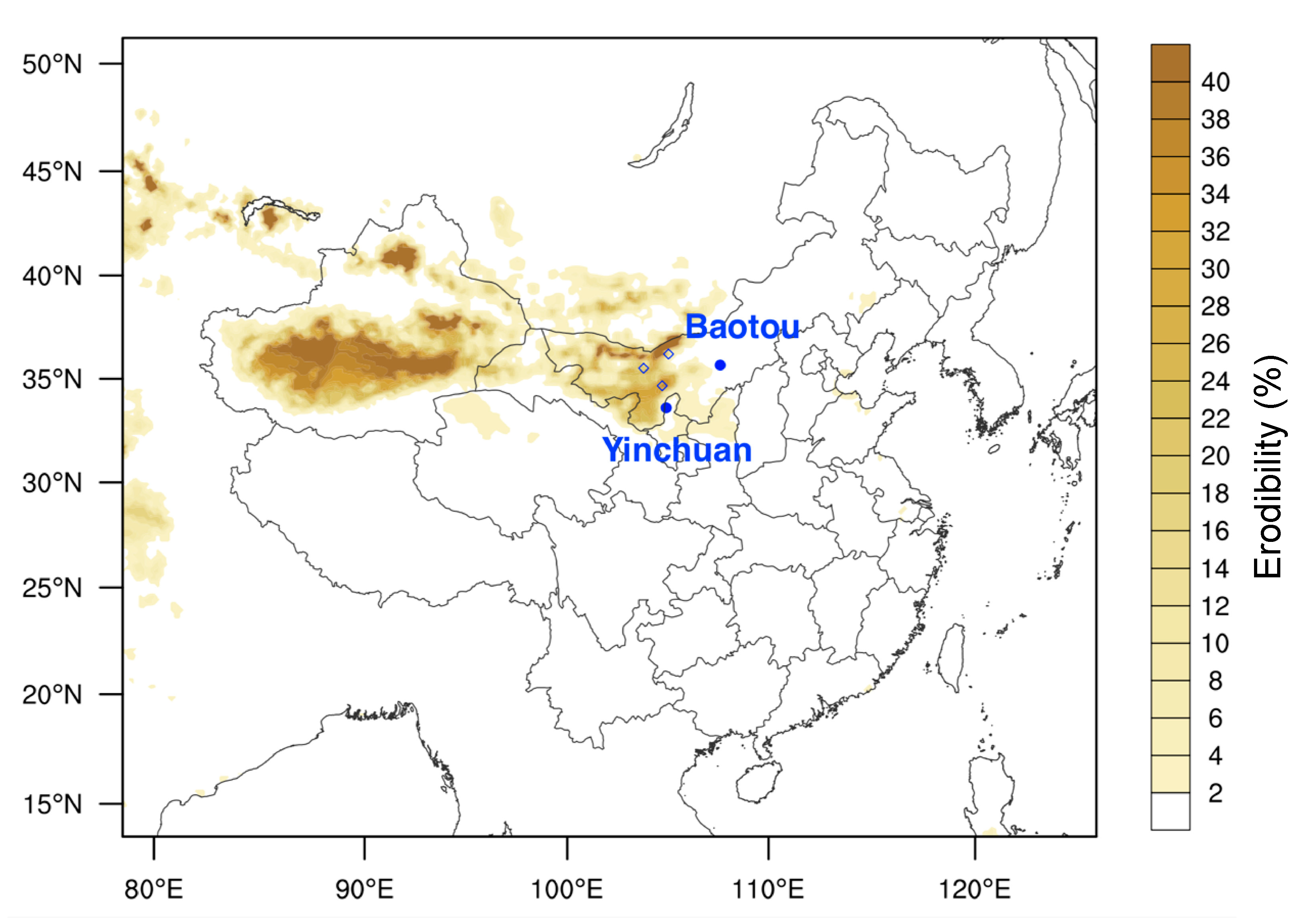

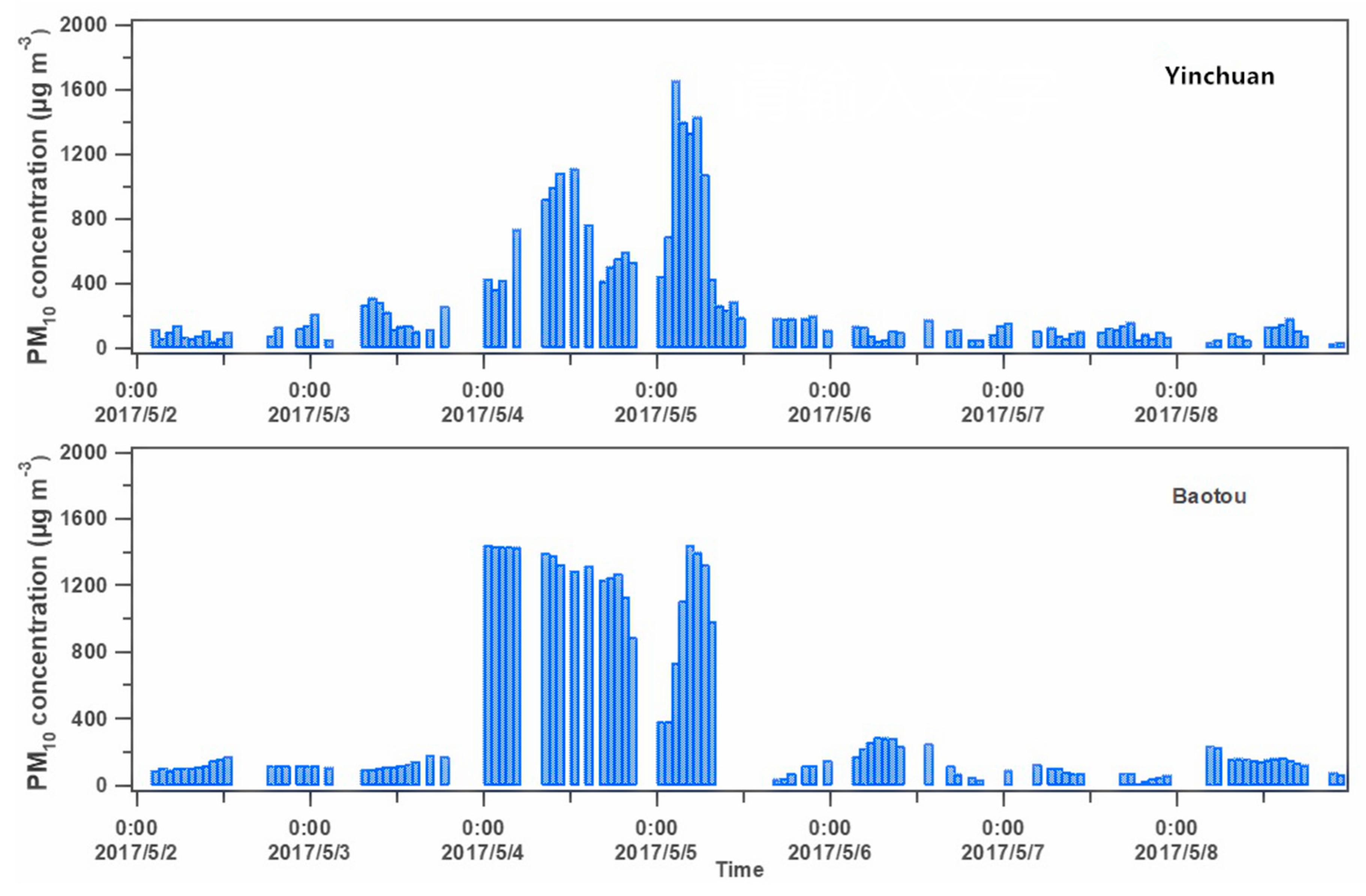
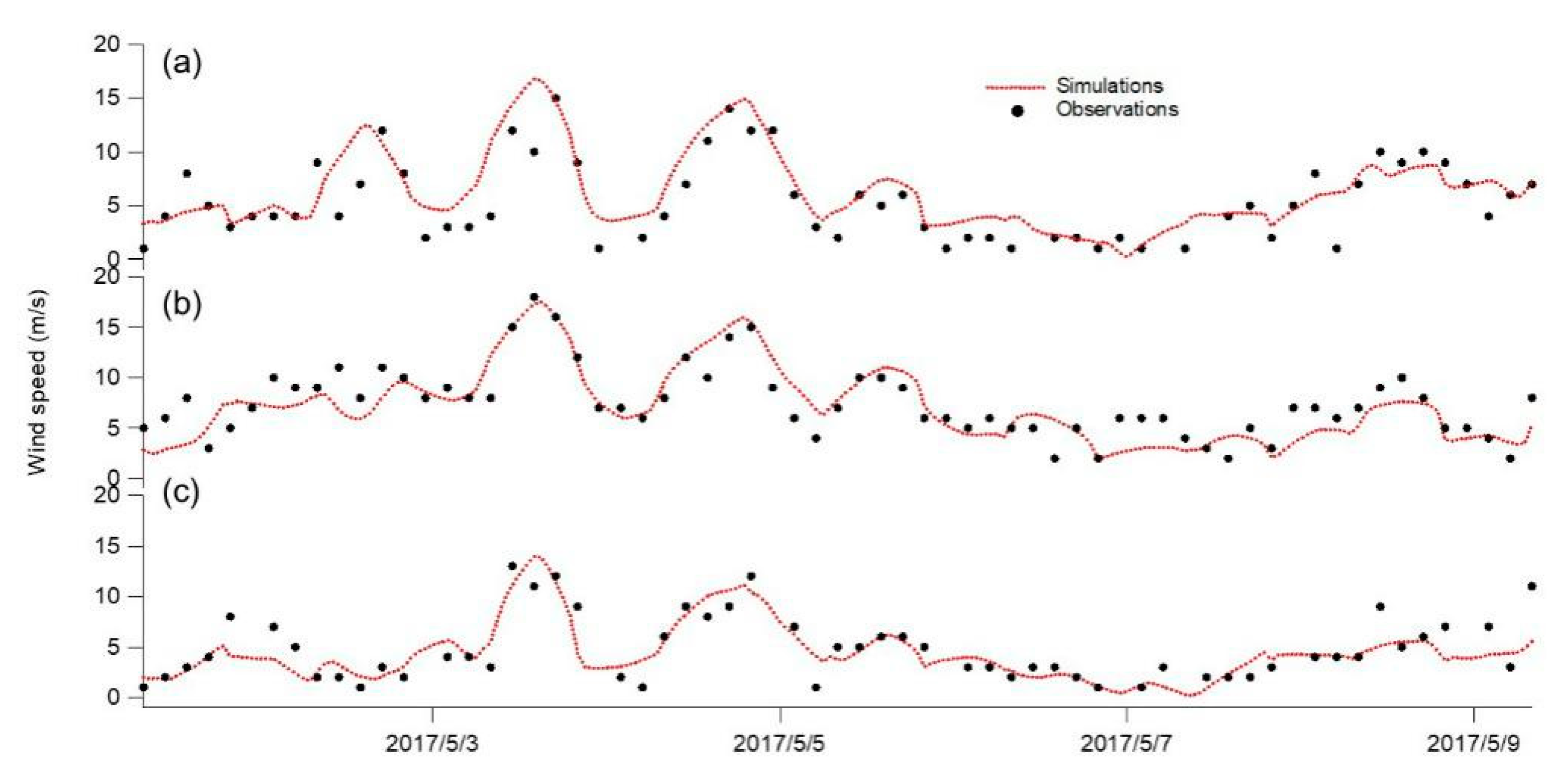
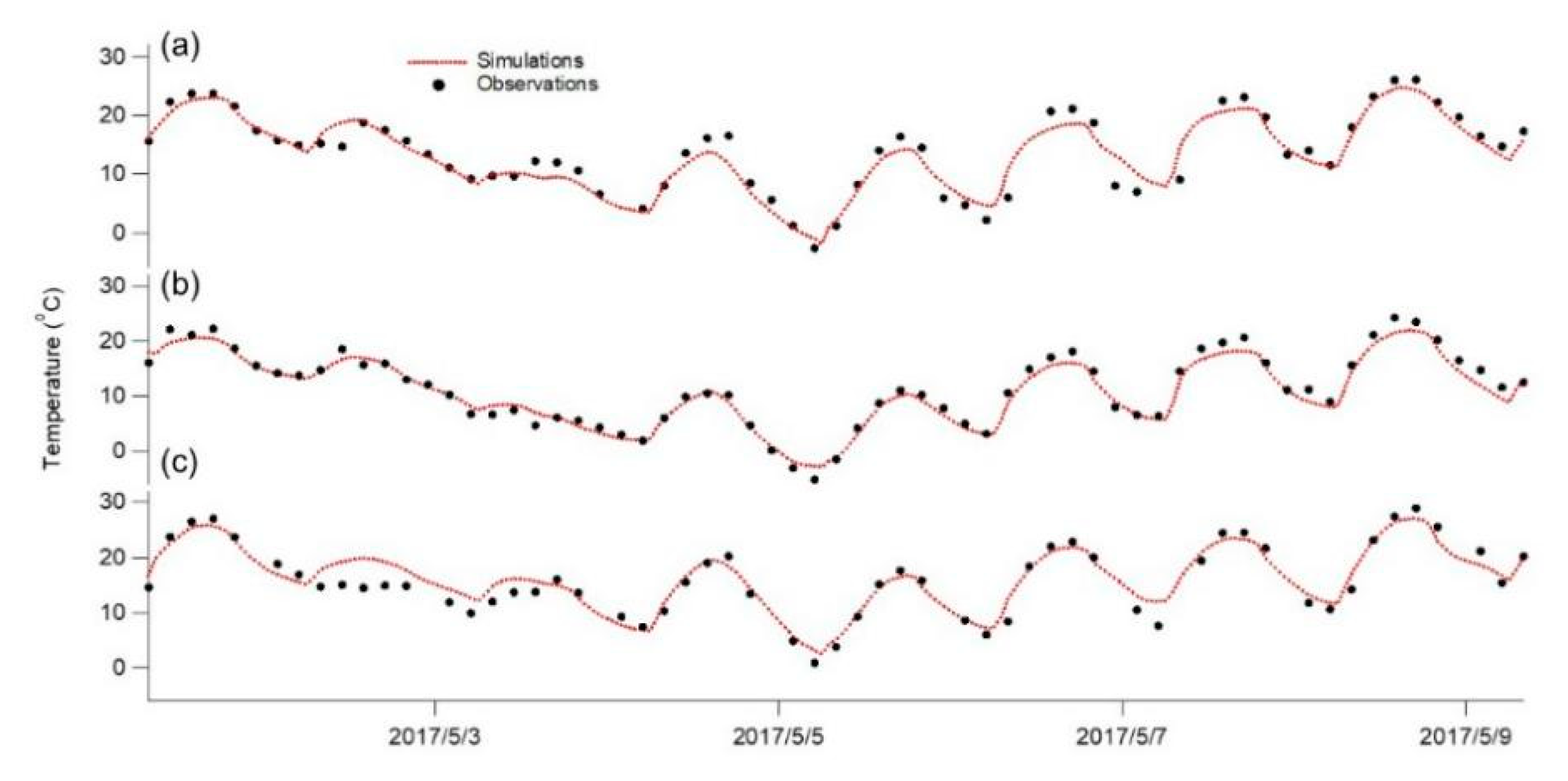
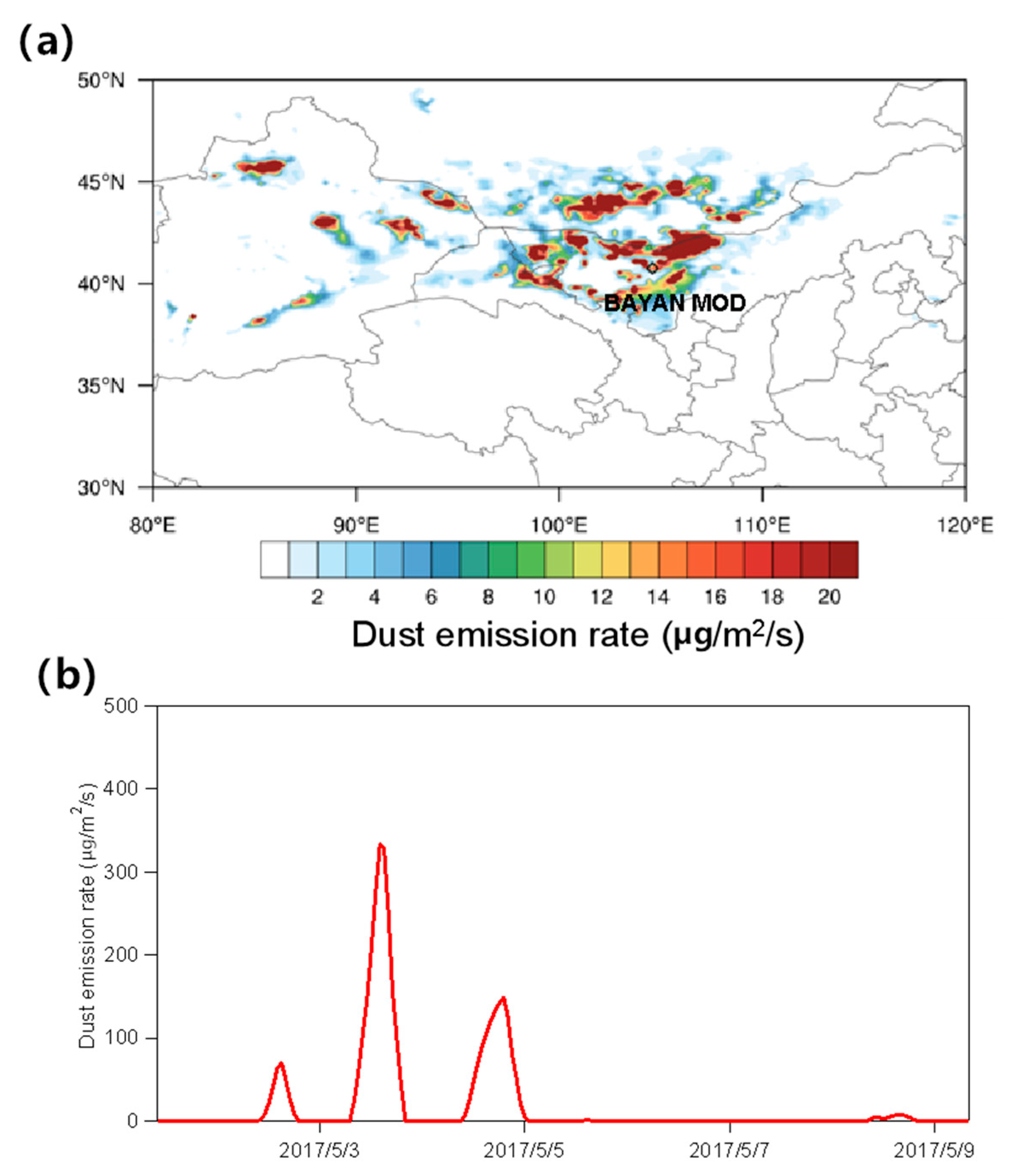
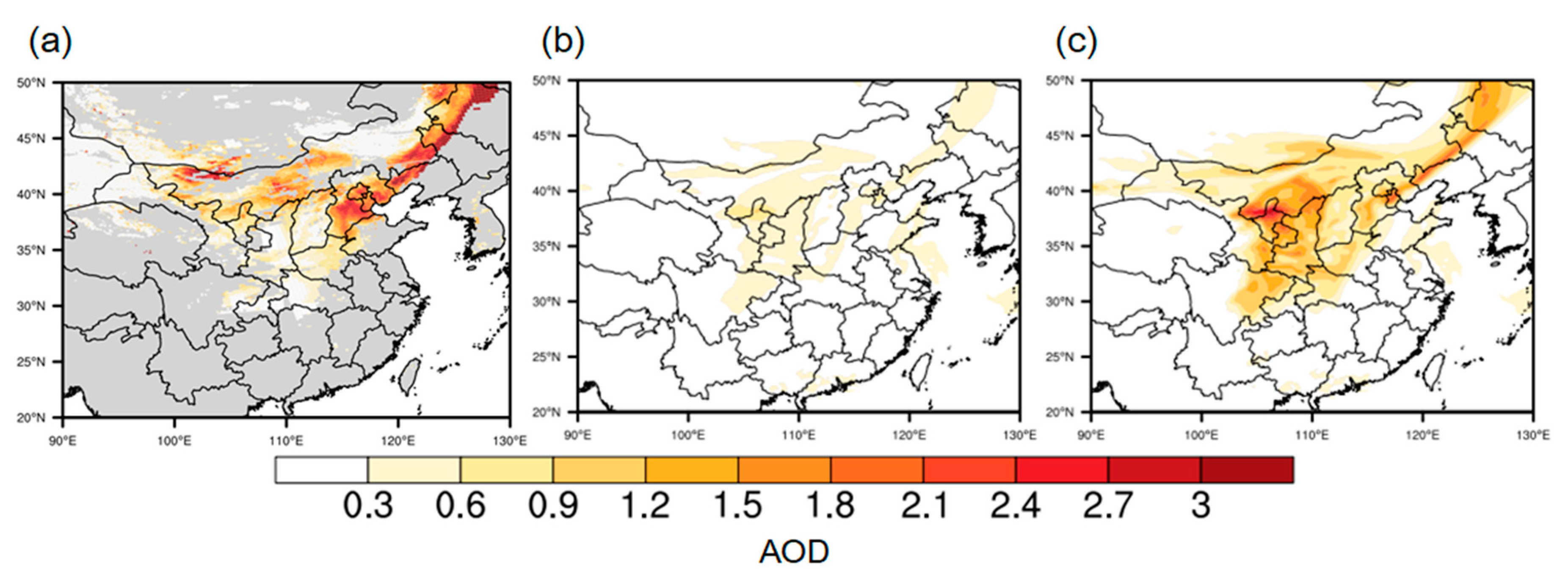

| Domain Setting | |
| Horizontal grid | 281 × 231 |
| Grid spacing | 20 km × 20 km |
| Vertical layers | 30 eta levels |
| Map projection | Lambert conformal conic |
| Configuration Options | |
| Longwave radiation | RRTMG |
| Shortwave radiation | RRTMG |
| Cumulus parameterization | Grell-Deveny |
| Land surface | unified Noah |
| Boundary layer | YSU |
| Microphysics | Lin et al. |
| Photolysis | Fast-J |
| Dust emission estimation | GOCART |
| Gas-phase chemistry and aerosol scheme | CBMZ and MOSAIC |
© 2019 by the authors. Licensee MDPI, Basel, Switzerland. This article is an open access article distributed under the terms and conditions of the Creative Commons Attribution (CC BY) license (http://creativecommons.org/licenses/by/4.0/).
Share and Cite
Song, P.; Fei, J.; Li, C.; Huang, X. Simulation of an Asian Dust Storm Event in May 2017. Atmosphere 2019, 10, 135. https://doi.org/10.3390/atmos10030135
Song P, Fei J, Li C, Huang X. Simulation of an Asian Dust Storm Event in May 2017. Atmosphere. 2019; 10(3):135. https://doi.org/10.3390/atmos10030135
Chicago/Turabian StyleSong, Ping, Jianfang Fei, Changshun Li, and Xiaogang Huang. 2019. "Simulation of an Asian Dust Storm Event in May 2017" Atmosphere 10, no. 3: 135. https://doi.org/10.3390/atmos10030135
APA StyleSong, P., Fei, J., Li, C., & Huang, X. (2019). Simulation of an Asian Dust Storm Event in May 2017. Atmosphere, 10(3), 135. https://doi.org/10.3390/atmos10030135





